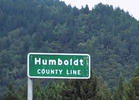
You may think a non-fiction book about Humboldt County would wax nostalgic about the most famous weed-growing destination in the U.S. But instead of smoked-out tales of counterculture glory, Emily Brady's Humboldt: Life on America's Marijuana Frontier delivers nuts-and-bolts personal stories of people in and around the Northern California county’s booming black market trade in cannabis. Rather than feed into the mythology, Brady delves into the realities behind it with plenty of good old-fashioned investigative reporting.
This is not a rural, real-life version of say, Pineapple Express. The author presents a clear-eyed view of the pot business through four main characters: a cop, a commercial cultivator, an aging flower child who still grows outdoors and a twenty-something female social worker that grew up around the trade.
The potential and often-realized wealth of growing pot comes with plenty of risks. Like any agricultural trade, it’s hard work. Your crop can get turned into waste by mold, or worse yet, get stolen by thieves, eaten by rodents, or spotted from the air by the cops and confiscated. The payoff may be huge at times, but plenty of folks end up going to jail or the cemetery.
Drawn by the natural beauty of the redwood forests, ample water, and hundreds of hilly, cheap and secluded square miles, Humboldt County attracted Bay Area hippies during the '60s to a mostly poor community formerly known for logging and fishing. Riding the broader back-to-the land and communal living movement, baby boomers began growing their own marijuana for personal consumption. Then they started selling some of it, and the rest is history, at least among the millions of stoners familiar with the product.
By the '80s, as Humboldt played a major role in supplying high-grade sinsemilla, helicopters filled the skies and troops landed to pull up the plants, prompting locals to stage public protests in favor of legalization. Yet, some 25 years later, in 2010, a majority of Humboldt residents voted against the legalization initiative Prop 19 because they feared it would cause prices to collapse.
If you drive up past the redwoods today, there’s no museum or pot farms open for visitors, unlike nearby Napa Valley, famous as a vacation spot for wine lovers. The marijuana is grown in secluded, private areas deep in the woods, or in closely-guarded home operations and hidden commercial greenhouses. While some have permits to grow weed in the open for medical use, much bigger bucks come from the black market. Talk of playing up Humboldt County as a destination for pot tourism remains a subject of conversation, but little concerted action.
Pot ranks as the region's biggest industry by far, and the growers have supported community centers and plenty of other civic institutions, including KMUD, the local radio station that covers the trade. They've even funded the election of the local district attorney.
Crockett, the commercial grower and in some ways the most fascinating character in the book, also serves as a volunteer firefighter, partly because he usually gets away with speeding when he shows cops his special ID.
The author provides no first-hand accounts of enjoying Humboldt’s most famous export, but she plainly supports legalization as a way to cut costs of pot prohibition and reduce the human tragedies caused by throwing hard-working, non-violent growers in jail. Even the local cop profiled in the book agrees that taxing and regulating marijuana for the common good makes more sense than prohibition.
Brady, who lived in the county for a year while researching Humboldt, reveals many of its secrets. Some in the business unfortunately resort to violent crimes as they’re pushed to extremes to avoid the law and protect their business. But most are ordinary people trying to make an honorable living. As the Bob Dylan quote at the beginning of the book says, “To live outside the law, you must be honest.” Amen to that.






